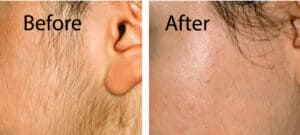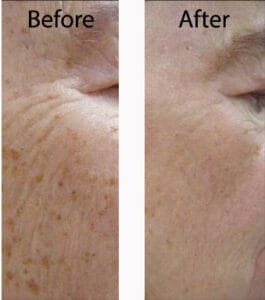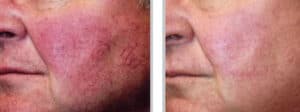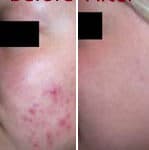IPL for the Removal of Brown Spots, Red Spots, Acne and Hair; An scientific editorial
IPL – Removes brown spots, red spots, acne and hair…Can it really do everything?
Nearly everyone at some point in their life has been bothered by a red spot on their skin. Whether it’s been acne, a small blood vessel or another type of red spot on the face, we all experience this at one point. Brown spots tend to appear as we age or during pregnancy and can really stand out on people’s skin, particularly in those with light skin. What about acne? I am sure most of us have developed a pimple or two over our lifetime while some of us have had more serious breakouts. Many people may still be dealing with the lasting effects of acne. What about excess or unwanted hair? Again, there are many of us out there who wish there were areas of our bodies where we had less or no hair.
There is a technology that has the ability to treat all of these problems; safely, effectively and at a relatively low cost with little or no downtime for the vast majority of people. So what is the catch? How does it work? Is it safe? The goal of this educational piece is to conduct a complete and in-depth review of IPL, otherwise known as Intense Pulsed Light treatment for the skin. I will include everything from my opinion and experience to what has been demonstrated scientifically. The goal of this editorial is to try and provide an honest, up to date and scientifically sound discussion of IPL treatments.
Part 1 – The History of IPL and How IPL Works
History of IPL – Intense Pulsed Light

The original idea for IPL was developed in 1976 by Muhlbauer for the treatment of vascular (blood vessel type) problems with the skin. This system had limitations and high rates of complications so it was modified in 1990 and then commercially launched in 1993. Since 1993, we have learned a lot and multiple modifications have been made in order to improve the effectiveness and safety of this device.
How Does IPL Work?
Ok, so this can get complicated so I will do my best to describe this as clearly as possible. For all you physics junkies out there (like me) don’t judge me too harshly on leaving out mathematical details, this is meant as a basic discussion!
IPL stands for intense pulsed light. Some people think of it as a laser, but it is not a laser. One key difference is that a laser is what we call “monochromatic” or “one color.” You can think of a laser as being one specific color of the rainbow or one “wave-length” of light. IPL on the other hand is what we call “Broad-spectrum” light or “polychromatic.” Remember, Mono means one (one color) and poly means many (many colors mixed together). So, IPL treatment is a number of colors mixed together forming a very bright light. To summarize, when using lasers high energy monochromatic (or single color) light is applied to the skin while IPL uses polychromatic (or multiple color) light that is applied to the skin.

An IPL machine is comprised of an electrical energy source that creates light (like a light bulb). This light bulb contains a special gas called xenon that increases the intensity of the light to very bright levels. The device therefore converts electrical energy (power from the wall) to very bright light (or optical energy). Now, this is where things start to get a bit tricky, however it is crucial in order to understand how IPL works. When we look at light each individual color of the rainbow has a specific wave-length. Think of it like a key on the piano, middle C on the piano is 261 Hz (Hz means hertz which means waves per second so C would be 261 waves per second of time) while the A note is 440 Hz. This is how our ears work, different hertz sound like different notes. These waves are just like waves on a beach. If the waves were crashing on the beach twice every second, you’d have 2Hz. Light works in a similar way, it has wave-lengths, but they are MUCH faster and we cannot hear light, we can only see light (obviously). When we look at light from a physics point of view, we talk about it in terms of the length of the wave (just like an ocean wave). Light waves are VERY small. Depending on the wavelength, it can either be absorbed by the surface or reflected off of any surface it hits. If 100% of the light is absorbed, guess what color we see? The answer is Black, because NO light returns to our eyes. If 0% of the light is absorbed, we see white. However, we typically have situations in between these two extremes. Sometimes, the surface the light is shining on only reflects the color blue, which means we will see blue. The opposite can be true as well and this is the KEY to understanding IPL treatment. Red lesions reflect and do NOT absorb red, but they absorb other colors. Brown lesions absorb some colors, but not all.
The KEY to Understanding How IPL Works
Now after all that physics talk, how does IPL work? Well, in our skin we have what are called Chromophores. A chromophore is simply anything that absorbs light. The brown pigments in brown lesions are considered a chromophore, as are the red pigments in the hemoglobin in our blood cells. The same goes for the dark brown and black pigment at the base of our hair. When IPL shines on your skin, the Chromophores or the color absorbs the energy of the light at a specific wavelength and this then causes the chromophores (or pigment) to heat up. By heating them up, they are broken apart and will fade away. So in the end, the energy from the light is transferred to the color in your skin and results in the color heating up and being broken down and removed.
Part 2 Treatments
What can be Treated with IPL?
The most common conditions treated include Acne, pigmented skin (brown and red spots), vascular (blood vessel) lesions, unwanted hair, sunspots (brown lesions), red scars and other skin color changes like rosacea.
In a moment, I will discuss the effectiveness of the treatment for each of these lesions. One of the key articles I will use for this is an article by Babilas published in 2010 in the Journal of Lasers in Surgery and Medicine. In addition to this, I will add discussions from an excellent article by Wat et al ( 2014). This is a brand new article in which the researchers conducted a systematic review and assessed all the published articles on the topic of IPL treatments. In total, the researchers reviewed a total of 127 studies on IPL. This study allows researchers to grade the research according to different levels, such as strong, moderate and weak. This allows us to give recommendations based on how powerful the studies were.
Hair Removal
IPL works on hair by causing the pigment or color at the base of the hair follicle to heat. The light heats the end of the hair follicle and this causes it to die. The limitation with IPL treatment for hair, is that it only effects hair that is in the growth phase. All our hair goes through growth and resting phases, and only those hairs that are in the growth phase are impacted by IPL. This is why multiple treatments are needed and why not all hair is treated with IPL. Another important limitation is that the darker the hair, the better the chance of hair removal. Light colored hair typically does not respond to IPL as it has no color to absorb.

There have been numerous studies on IPL and hair removal. One study by Toosie (et al 2006) noted that after 3-6 treatments IPL treatments show results that were comparable to other lasers. The use of IPL resulted in a 67% reduction in hair at the treated area and it demonstrated a lower chance of side effects compared to standard laser treatments
Another study by Feng et al (2008) determined that IPL was effective for hair and safe in people with olive to dark brown skin tones. After four sessions, there was an 84% reduction in hair with no change in skin color or complications. This however, is controversial. Some people will not use IPL in dark skin tones as there is a risk of loss of skin color.
Overall, IPL is very effective when used for hair removal. The safety profile is excellent and patients can rest assured that if done properly, they should see good results.
Pigmented Lesions – Brown Sports or Red Spots.

Anytime you are about to be treated for a brown or red spot, the first thing you require is a good examination by a physician. It is very important to ensure that there are no signs of a skin cancer. Although rare, this is something that cannot be missed.
Another important consideration is that IPL is not the best treatment for moles. It can work, but it is not always the best first treatment. They can treat other brown spots, but not common moles.
Melasma (dark spots that form on the skin) and lentinges (age related brown spots) can be treated with IPL. Numerous studies have demonstrated that it is effective for this. A study by Li (2008) noted that the color of these lesions is reduced by at least 50% in 2/3rds of people treated. A study by Galeckas (2008) had similar findings, reporting an 82% reduction in brown spots after three treatments.
One final note, after conducting the large assessment of all studies, there is moderate research supporting the effectiveness of IPL on sun damaged related brown spots and age spots however there is strong evidence supporting the effectiveness on melasma (often occurs during pregnancy). In both cases, there is a low risk of complications and a high chance of improvement in these lesions.
Vascular Lesions
There are numerous types of vascular lesions and I’ll try to cover the most common ones. IPL works on vascular lesions by being absorbed by the red color of hemoglobin in your blood cells.
Port Wine Stains

Port wine stains are a blue-purple color that can occur on the body, typically the face. They are typically present at birth and can often be seen in young children. Some adults have these their whole lives and decide to treat them later in life. The are not dangerous however can be bothersome to people.
Numerous studies have shown that IPL can be effective for this. Typically, IPL can reduce the appearance of these lesions by 25-50%. These treatments are safe and there have been no significant side effects noted.
Rosacea

Rosacea is similar to acne, however there are some differences. Typically, people notice redness across their nose and cheeks. In addition to this, you can notice small “telangiectasias” which are small little blood vessels on the skin.
IPL has demonstrated anywhere from 50-80% reduction in these lesions when treating Rosacea. This results in people having less redness and fewer telangiectasias. According to Bjerring (2001) most patients can expect at least a 50% or more reduction in these problems.
There is moderate evidence overall supporting the use of IPL in rosacea.
Acne

Interestingly, IPL also has an effect on acne. The light from IPL interacts with bacteria in the skin that is prominent in acne that can kill the bacteria. Also, it can reduce the amount of thick oil the skin produces. A study by Yeung (2007) demonstrated a 43% reduction in acne lesions after 4 treatments. Another study by Chang assessed whether adding IPL to standard cream based acne treatment would improve the appearance of the skin. The study noted that if you add IPL to benzoyl peroxide, you can get up to a 63% improvement in red lesions, irregular color and skin tone.
The one issue with acne treatment is that long term treatments have not yet been conducted. However, there is moderate to strong evidence for Acne treatment with IPL according to the study by Wat et al (2014).
Part 3 – What is the process for an IPL Treatment?
How does it feel to get an IPL Treatment? Is an IPL treatment painful?
The most common sensation people get from IPL is a quick, sharp discomfort due to the light heating the skin. The vast majority of people do not have excessive pain levels. However, pain is very individual and we all have our own unique pain thresholds. Cooling the skin can dramatically reduce this discomfort. Sometimes we use a small amount of freezing gel to help reduce the pain. However there is a risk of using freezing gels. If you have no pain and the IPL settings are too strong for your skin, you may not notice this and end up having too much heat applied to your skin, this can cause a burn.
What are the most common side-effects of an IPL Treatment? What is the downtime after an IPL Treatment?
The most common side effect is redness and mild puffiness to the treated skin. This usually lasts a few hours to a day and is mild. Most people are not bothered by this and go back to work the same day. A study by Fodor et al (2009) noted that nearly 67% to 75% of patients will have no complications when treating vascular lesions or hair removal.
Rarely, people can develop blistering (like a sunburn) from the treatment. If this happens, you treat it like a sunburn and keep it covered and clean.
Are there any Serious or Long-Term Side Effects of IPL Treatment?
I always tell my patients, if you ever see a health care provider who says there are no side-effects to a drug or treatment, they are being dishonest. Everything we do has the potential to have a side-effect, it may be 1 in 1,000,000 but there is still a chance. IPL is no different. Although it is very safe there are some potential rare side effects. I will try my best to provide an honest discussion of the potential side effects.
- Hyper or Hypo Pigmentation: This means, you can get lightening (hypo) or darkening (hyper) of the treated skin. This is most commonly temporary however it can be permanent. We do everything we can so as not to over treat the skin, which is the most common cause of these changes. People with very dark skin are at a higher risk for having a lightening effect to the skin, so we treat people with these skin tones very carefully if at all.
- Scars: This is a very rare complication and happens when people are treated too aggressively. People often want dramatic results, but remember safety comes first.
- Increased Hair Growth: This is very rare as well. In some people, they can have an increase in hair growth or they can have the dark hairs turn light colored.
The most important way to reduce the chance of side effects is to conduct a “test patch” first. A test patch means, we treat an area of your skin where you don’t often look (such as the back of your neck, under your hair). If the settings we use for you cause no trouble on the test patch, there is a low chance of it causing trouble anywhere else.
One final note, in all of the studies (127 studies) reviewed by Wat et al (2014) there were only 4 cases with long lasting serious complications. One was the development of a cold sore on the lip, one was prolonged ulceration after treatment and two cases had scarring.
Is IPL Treatment Safe in those with Very Dark Complexions like Dark Mediterranean and African Skin Tones?
Unfortunately, many of the treatments we have in cosmetic medicine pose an increased risk to people with darker skin tones. This can make treating people with these ethnic backgrounds very difficult and frustrating. One of the biggest problems is the lack of research into people with darker skin tones.
The key differences between individuals with dark skin and those with light skin is the amount of melanin (the color pigment) in the skin. Remember, melanin is a chromophore and can absorb the light. Another challenge is that darker skinned individuals tend to have a higher risk for abnormal scar formation; therefore much care must be taken when treating.
Unfortunately, IPL treatment is not typically recommended in dark skinned individuals due to the significant risk of increased skin color or even lightening the skin color. The risks likely outweigh the benefits for people with dark skin tones. There are however, other types of lasers than can be safely used on dark skin tones.
What happens during an IPL Treatment?
You come in, the machine will be set up. You will be given special glasses as will the person treating you. This is important as IPL light can damage your eyes if not protected. At this point, a gel will be put on your skin and then the IPL will be applied over the skin you want treated. Then, you will feel VERY brief moments of heat and very bright flashes of light. Even with the glasses and your eyes closed, you will still know that there is light flashing. During the treatment, cold will be applied to your face to keep you comfortable.
The treatment takes 15-20 minutes at the most.
How Often do I need a treatment?
Most people require 3 treatments, scheduled about 6-8 weeks apart. Some people see dramatic effects after one treatment, but ideally 3 treatments are required. If you look at research, most studies treat patients 3-4 times.
What happens after the Treatment?
It is very important that after treatment you either stay out of the sun or use sunscreen for at least 8 weeks after treatments. If not, you can develop changes in the color of your skin.
You may start to notice some light flaking of the skin and it is important not to peel it off. Just let it do its thing. Keep it moist and if pain develops, let your physician know.
Summary
After all this information, I think it is obvious that IPL treatment is safe, effective and a great way to treat a number of different problems with your skin. If you have any questions about IPL, feel free to post some questions and I’ll do my best to answer.
Thank you,
James P. Bonaparte, MD, MSc, FRCSC
JB Cosmetics and Facial Surgery Center of Ottawa
Head and Neck Surgery
practicing in Facial Plastic and Reconstructive Surgery
Assistant Professor, University of Ottawa
Ottawa, Ontario, Canada
www.drbonaparte.com
Categories:
- Blepharoplasty
- Botox
- Cost
- Dermatology
- Digital IMaging
- DLM FAQ
- Earlobe Repair
- facelift
- Facial Plastic Surgery
- Fillers
- Forehead Lift
- Healing Time
- In the News
- Injectables
- IPL
- Lasers
- Male Plastic Surgery
- Microdermabrasion
- Microneedling
- Non-Surgical
- Opinion
- Others
- Platelet Rich Plasma
- Research Review
- Rhinoplasty
- Skin Care
- Skin Tightening
- Specials
- Uncategorized
Choose Category
- Blepharoplasty
- Botox
- Cost
- Dermatology
- Digital IMaging
- DLM FAQ
- Earlobe Repair
- facelift
- Facial Plastic Surgery
- Fillers
- Forehead Lift
- Healing Time
- In the News
- Injectables
- IPL
- Lasers
- Male Plastic Surgery
- Microdermabrasion
- Microneedling
- Non-Surgical
- Opinion
- Others
- Platelet Rich Plasma
- Research Review
- Rhinoplasty
- Skin Care
- Skin Tightening
- Specials
- Uncategorized



